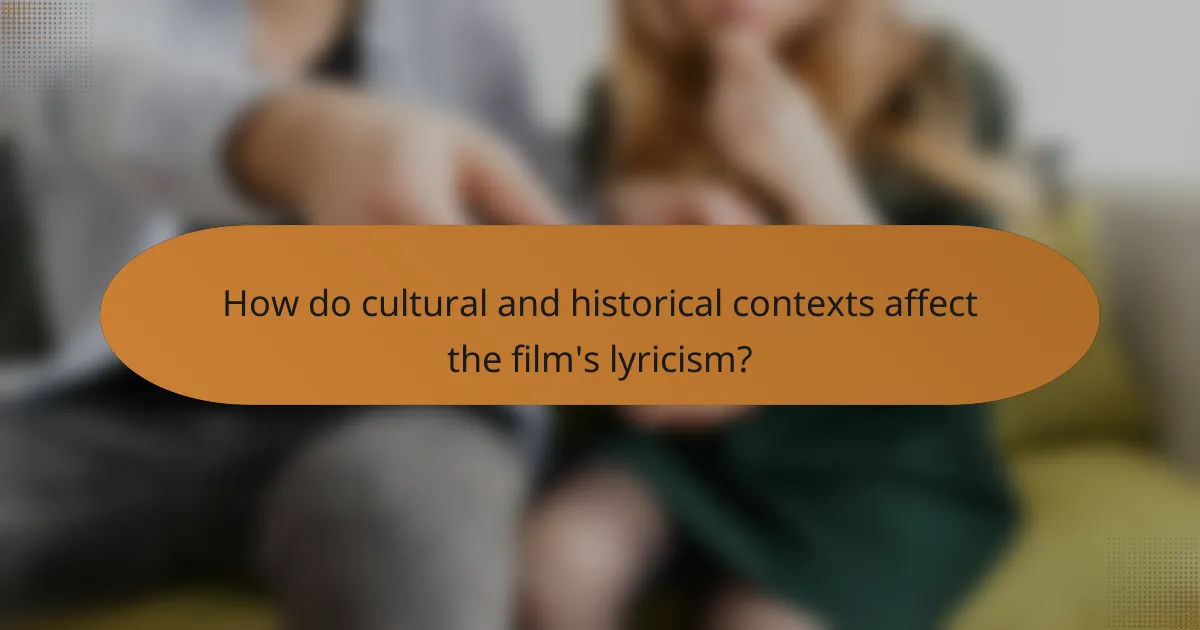The article explores the lyricism in “Umbrellas of Cherbourg,” focusing on the film’s use of song and poetic dialogue to express emotions. It highlights how the narrative is uniquely structured through sung dialogue, enhancing character depth and emotional resonance. Key elements discussed include the film’s score by Michel Legrand, non-linear storytelling, visual symbolism, and color symbolism, all of which contribute to the lyrical quality of the narrative. Additionally, the article examines the cultural and historical contexts influencing the film’s themes of love and loss, particularly during the social changes in 1960s France. Overall, the article provides an analysis of the poetic devices and narrative techniques that elevate the film’s emotional impact.

What is Lyricism in Umbrellas of Cherbourg?
Lyricism in “Umbrellas of Cherbourg” refers to the film’s use of song and poetic dialogue to convey emotions. The entire narrative unfolds through sung dialogue, creating a unique lyrical structure. This approach enhances the emotional depth of the characters’ experiences. The film’s score, composed by Michel Legrand, complements the lyrical quality. Each song reflects the characters’ feelings and conflicts. The use of vibrant colors and visual storytelling further amplifies the lyrical nature. This combination of music and visuals creates an immersive experience. Overall, the lyricism serves to elevate the narrative and emotional impact of the story.
How does lyricism contribute to the overall narrative of the film?
Lyricism enhances the overall narrative of the film by deepening emotional resonance. The use of song lyrics conveys characters’ feelings and motivations effectively. This technique allows for a more intimate connection between the audience and the characters. Each song serves as a narrative device that progresses the plot. For instance, the lyrics reflect the characters’ inner turmoil and desires. This creates a layered storytelling approach that combines visual and auditory elements. The film’s structure relies heavily on this lyrical storytelling to maintain engagement. Ultimately, lyricism transforms dialogue into a poetic experience, enriching the narrative arc.
What are the key themes expressed through the lyrics?
The key themes expressed through the lyrics include love, longing, and the passage of time. Love is depicted as a central emotion driving the narrative. Longing is expressed through the characters’ desires and unfulfilled dreams. The passage of time is illustrated by the changing seasons and life events. These themes create a poignant reflection on human experiences. The lyrics encapsulate the bittersweet nature of relationships. They highlight the interplay between joy and sorrow. The emotional depth resonates with audiences, making the themes universally relatable.
How do the lyrics reflect the emotional landscape of the characters?
The lyrics in “Umbrellas of Cherbourg” vividly reflect the emotional landscape of the characters. They convey feelings of longing, love, and heartache through their poetic structure. The use of repetition emphasizes the intensity of emotions experienced by the characters. Imagery in the lyrics paints a picture of their internal struggles and desires. Each line captures a moment in time, illustrating the characters’ emotional states. The melodic quality of the lyrics enhances their emotional impact. The interplay of hope and despair is evident throughout the song. This emotional depth resonates with the audience, making the characters’ experiences relatable.
What poetic devices are utilized in the film’s lyrics?
The film’s lyrics utilize various poetic devices such as imagery, metaphor, and repetition. Imagery creates vivid pictures in the audience’s mind, enhancing emotional connection. Metaphors draw comparisons that deepen meaning, enriching the narrative. Repetition emphasizes key themes and emotions, reinforcing the lyrical message. These devices work together to create a unique lyrical experience.
How do metaphors enhance the storytelling in Umbrellas of Cherbourg?
Metaphors enhance the storytelling in Umbrellas of Cherbourg by deepening emotional resonance. They create vivid imagery that conveys complex feelings. For instance, the recurring motif of umbrellas symbolizes protection and vulnerability. This metaphor illustrates the characters’ struggles with love and loss. Additionally, metaphors allow for layered meanings, enriching the narrative experience. They invite viewers to interpret the story on multiple levels. The film’s use of color as a metaphor for mood further amplifies emotional impact. Overall, metaphors serve as a powerful tool to engage the audience and evoke empathy.
What role does imagery play in the lyrics of the film?
Imagery plays a crucial role in the lyrics of the film “Umbrellas of Cherbourg.” It enhances emotional depth and creates vivid mental pictures. The lyrics use imagery to evoke feelings of love, longing, and nostalgia. Specific scenes are painted through descriptive language, allowing viewers to connect with the characters’ experiences. For example, references to colors and weather symbolize emotional states. This technique immerses the audience in the story’s atmosphere. The effectiveness of imagery in the lyrics contributes significantly to the film’s overall impact and storytelling.
How is language used to convey meaning in the film’s lyrics?
Language in the film’s lyrics conveys meaning through vivid imagery and emotional resonance. The lyrics use descriptive language to paint scenes and evoke feelings. For example, phrases often reflect longing and nostalgia, enhancing the narrative. Repetition of key phrases emphasizes emotional states and themes. Additionally, the use of metaphor enriches the lyrics, allowing for deeper interpretations. The lyrical structure mirrors the film’s pacing, creating a rhythmic flow that complements the visuals. This integration of language and music amplifies the overall impact of the story. Each lyric contributes to character development and plot progression, making them essential to the film’s emotional depth.
What linguistic techniques are employed to create rhythm and flow?
Linguistic techniques employed to create rhythm and flow include repetition, alliteration, and varied sentence length. Repetition reinforces key themes and enhances memorability. Alliteration creates a musical quality, making phrases more engaging. Varied sentence length contributes to a dynamic pace, maintaining reader interest. These techniques work together to establish a cohesive and lyrical narrative. In “Umbrellas of Cherbourg,” these elements help convey emotion and enhance the storytelling experience.
How does the choice of vocabulary impact the audience’s perception?
The choice of vocabulary significantly shapes the audience’s perception. Specific word choices evoke distinct emotions and associations. For example, using descriptive adjectives can create vivid imagery. This imagery enhances the audience’s emotional engagement with the narrative. Conversely, simplistic vocabulary may lead to a lack of depth in understanding. Research shows that varied vocabulary increases audience interest and retention. A study by the University of California found that rich language improves listener engagement. Thus, vocabulary directly influences how the audience connects with the content.

What narrative techniques are evident in the film?
The film employs several narrative techniques, including non-linear storytelling and visual symbolism. Non-linear storytelling allows for a fragmented timeline, enhancing emotional depth. The use of visual symbolism conveys complex themes through imagery. The dialogue is entirely sung, integrating music as a narrative device. This technique creates a unique lyrical quality, reflecting characters’ emotions. Additionally, color symbolism is prevalent, representing mood shifts and character development. These narrative techniques contribute to the film’s overall lyrical and poetic nature.
How does the structure of the narrative influence the lyricism?
The structure of the narrative significantly influences the lyricism by shaping the rhythm and flow of the lyrics. A linear narrative creates a straightforward progression, allowing for a clear emotional arc. This clarity enhances the lyrical quality, making it more relatable and impactful. Conversely, a non-linear structure introduces complexity, which can evoke deeper emotional responses. For example, flashbacks or shifts in time can create tension and anticipation, enriching the lyrical experience. The interplay between narrative structure and lyricism is evident in “Umbrellas of Cherbourg,” where the seamless integration of storytelling and song enhances both the plot and emotional depth. This technique exemplifies how narrative decisions directly affect lyrical expression, reinforcing themes and character development.
What is the significance of the non-linear storytelling approach?
The non-linear storytelling approach is significant because it enhances emotional engagement and reflects complex character development. This technique allows the audience to experience events out of chronological order. By doing so, it mirrors the fragmented nature of memory and perception. In “The Umbrellas of Cherbourg,” this method emphasizes the characters’ emotional states. It creates a sense of anticipation and surprise, enriching the narrative experience. Studies show that non-linear narratives can increase viewer investment in characters and themes. This approach also encourages deeper analysis of plot connections and themes. Overall, it transforms storytelling into a more interactive and reflective experience for the audience.
How do flashbacks and foreshadowing interact with the lyrics?
Flashbacks and foreshadowing interact with the lyrics by enhancing narrative depth and emotional resonance. Flashbacks provide context and background, revealing characters’ past experiences. This technique allows listeners to understand motivations and emotions more profoundly. Foreshadowing, on the other hand, hints at future events, creating anticipation and tension. It prepares the audience for developments in the story. Together, these devices create a cohesive narrative structure. They guide the listener’s emotional journey through the lyrics. This interplay enriches the overall experience of the music. It transforms simple storytelling into a complex emotional landscape.
What role does character development play in the lyrical content?
Character development is crucial in lyrical content as it enhances emotional engagement. The lyrics reflect the inner thoughts and growth of characters. This development allows audiences to connect with their experiences. For instance, in “Umbrellas of Cherbourg,” characters evolve through their relationships. Their changing emotions are expressed through the lyrics. This progression deepens the narrative and adds layers to the story. The audience gains insight into motivations and conflicts. Overall, character development enriches the lyrical experience and drives the narrative forward.
How are the characters’ journeys reflected in their respective songs?
The characters’ journeys in “Umbrellas of Cherbourg” are reflected in their respective songs through emotional expression and narrative progression. Each song encapsulates the character’s thoughts and feelings at pivotal moments. For instance, Geneviève’s song conveys her longing and despair over lost love. This mirrors her journey from hope to heartbreak. Similarly, Guy’s songs illustrate his struggle with duty and desire. His lyrics reflect the conflict between his responsibilities and his love for Geneviève. The musical structure enhances these emotional arcs, with changes in tempo and key underscoring shifts in character development. Overall, the songs serve as a narrative device, highlighting the characters’ internal conflicts and transformations throughout the story.
What can we learn about the characters through their lyrical expressions?
Characters reveal their emotions and motivations through lyrical expressions. Their lyrics often reflect inner conflicts and desires. For example, the longing for love is evident in the romantic exchanges. The use of metaphors highlights their emotional states, such as yearning and heartbreak. Additionally, the rhythm and tone convey urgency or despair. Specific phrases can show vulnerability or strength in character. The lyrical content provides insight into their relationships and social contexts. Overall, the characters’ lyrical expressions serve as a window into their psyche and life experiences.

How do cultural and historical contexts affect the film’s lyricism?
Cultural and historical contexts significantly shape the film’s lyricism. The Umbrellas of Cherbourg was released in 1964 during a period of social change in France. This era saw a shift towards modernism and a break from traditional cinematic forms. The film’s musical score and dialogue reflect these cultural transformations. The use of color and visual style represents the optimism of post-war France. Additionally, the narrative’s themes of love and loss resonate with the historical backdrop of the Algerian War. The film’s lyricism captures the emotional landscape of a generation grappling with change. Such contexts enhance the poetic devices used throughout the film. The interplay of music and narrative reinforces the depth of the characters’ experiences.
What influences shaped the lyrical style in Umbrellas of Cherbourg?
The lyrical style in “Umbrellas of Cherbourg” was shaped by various influences, including French chanson and operatic traditions. The film’s composer, Michel Legrand, integrated melodic structures typical of French popular music. This integration resulted in a seamless blend of dialogue and song, enhancing emotional depth. The use of vivid imagery and poetic language was influenced by the cinematic style of Jacques Demy. Additionally, the narrative’s exploration of love and loss drew from classic romantic themes. These elements collectively contributed to a unique lyrical experience that resonates with audiences.
How does the film reflect the socio-political climate of its time?
The film reflects the socio-political climate of its time through its portrayal of post-war France. It captures the struggles of individuals facing economic hardship and societal change. The backdrop of the Algerian War influences character motivations and decisions. The film’s vibrant colors contrast with the somber realities of life during this period. It also highlights themes of love and loss against a shifting political landscape. The music and lyrics echo the emotional turmoil of the era. This connection to historical context provides depth to the characters’ experiences. Overall, the film serves as a commentary on the intersection of personal and political challenges in 1960s France.
What cultural references are embedded within the lyrics?
The lyrics of “Umbrellas of Cherbourg” contain several cultural references. These references include mentions of Parisian life, which evoke the romanticism associated with the city. The song also alludes to the post-war era in France, reflecting societal changes and emotions of that time. Additionally, references to everyday objects, such as umbrellas, symbolize protection and longing. The lyrics often incorporate elements of French cinema, enhancing their artistic context. These cultural references provide depth and resonance, connecting the narrative to broader themes of love and loss.
What lessons can be drawn from the lyricism in Umbrellas of Cherbourg?
The lyricism in Umbrellas of Cherbourg teaches the importance of emotional expression in storytelling. It showcases how music and lyrics can convey complex feelings effectively. The use of repetition emphasizes longing and nostalgia throughout the narrative. Vivid imagery creates a strong sense of place and emotion. The integration of dialogue with song highlights the characters’ inner thoughts. Symbolism, such as the umbrellas, represents hope and protection. The lyrical structure mirrors the characters’ journey, enhancing the overall impact of the story. These elements collectively illustrate the power of lyricism in deepening narrative engagement.
How can understanding the lyrics enhance viewer engagement?
Understanding the lyrics enhances viewer engagement by deepening emotional connection. When viewers comprehend the lyrics, they can relate more personally to the characters’ experiences. This connection fosters empathy and investment in the narrative. Research indicates that emotional resonance increases viewer retention and enjoyment. For example, studies show that audiences engage more with content that evokes strong emotions, such as love or loss. In “Umbrellas of Cherbourg,” the lyrics convey complex emotions, enriching the viewing experience. Thus, understanding these lyrics allows viewers to fully appreciate the story’s depth and nuance.
What are some best practices for analyzing lyrical content in film?
Best practices for analyzing lyrical content in film include focusing on the interplay between lyrics and visuals. Examine how lyrics enhance character development and plot progression. Pay attention to the emotional tone conveyed through word choice and rhythm. Analyze the use of poetic devices such as metaphor, simile, and imagery. Consider the cultural and historical context of the lyrics. Evaluate how the music complements or contrasts with the lyrical themes. Review the impact of performance and delivery on audience interpretation. These practices ensure a comprehensive understanding of lyrical significance in film.
Lyricism in “Umbrellas of Cherbourg” serves as a central element that intertwines song and poetic dialogue to convey the film’s emotional landscape. This article examines how lyrical devices, narrative techniques, and language use contribute to character development and thematic exploration, focusing on key themes such as love, longing, and the passage of time. It also explores the impact of cultural and historical contexts on the film’s lyricism, highlighting the use of metaphors, imagery, and the significance of non-linear storytelling. Through this analysis, the article illustrates how the integration of music and lyrics enhances viewer engagement and emotional resonance.


